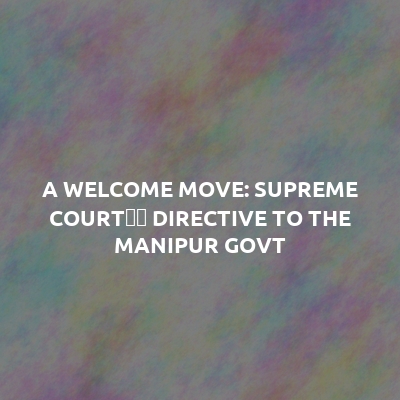The Supreme Court of India’s directive to the Manipur government to provide details of properties destroyed and encroached upon during the ethnic violence a year and a half ago is a significant and much-needed intervention. This judicial step comes amidst a crisis where executive action—both at the State and Union levels—has failed to address the root causes of unrest or provide tangible relief to the affected communities. The Court’s move reflects an active judiciary stepping in to uphold justice and accountability where governance has faltered.
The ethnic violence that erupted in Manipur in May 2023 not only destroyed lives and livelihoods but also exposed the fragile fabric of the State’s social and political systems. Ethnic hostilities between communities, compounded by the circulation of looted arms, have led to continued unrest, with incidents spreading even to previously unaffected regions such as Jiribam. Yet, despite the scale and persistence of the crisis, the responses from the Union and State governments have been marked by a lack of urgency and coherence. The Supreme Court’s intervention, therefore, is a timely step that redirects focus to the accountability of the authorities in ensuring justice, rehabilitation, and reconciliation.
One of the Court’s pivotal actions in this context has been extending the tenure of the Justice Gita Mittal-led Committee. This committee, tasked with supervising investigations into the violence and coordinating humanitarian aid, serves as a neutral body capable of ensuring impartial oversight in a deeply polarized environment. The directive to the State government to disclose property-related data further demonstrates the Court’s intent to hold the authorities accountable for the aftermath of the violence. Transparency in such matters is crucial for fostering trust among affected communities and initiating the process of rebuilding homes and lives.
The Court’s emphasis on judicial oversight, while unprecedented, is justified given the circumstances. Governance in Manipur has been crippled by divisions along ethnic lines, even among members of the same political parties. The State government has failed to bridge these divides or implement effective measures to curb violence and disarm non-state actors. On the other hand, the Union government’s apparent reticence in addressing the crisis, despite repeated demands from civil society and political opposition, has left a governance vacuum. It is within this vacuum that the judiciary has stepped in—not to usurp the role of the executive but to ensure justice and accountability.
The directive to disclose property damage and encroachment is not merely an administrative exercise; it is a foundation for rehabilitation and reconciliation. By identifying the extent of destruction and loss, the government can create targeted policies for compensation and reconstruction. Moreover, it sends a strong signal that the destruction of property, including places of worship, is not being overlooked, and perpetrators will be held accountable. Such actions are essential for restoring public confidence in the rule of law and the impartiality of the State.
However, the judicial intervention does not come without challenges. The government’s repeated invocation of “national security” to withhold findings and limit transparency has raised concerns. While national security is undoubtedly a critical consideration, it should not be used as a pretext to avoid accountability or shield failures in governance. The Supreme Court must remain steadfast in ensuring that the Justice Mittal Committee’s findings are made public and that the information gathered is used constructively to resolve the crisis.
Globally, post-conflict societies have embraced mechanisms such as truth and reconciliation commissions to heal divisions and rebuild social trust. These processes prioritize accountability, acknowledgment of harm, and steps toward justice. While Manipur’s situation is unique, adopting similar principles could pave the way for long-term peace. The findings of the Justice Mittal Committee could serve as the first step in this direction, highlighting the root causes of the violence and offering a roadmap for resolution.
The importance of the judiciary’s role in such crises cannot be overstated. It demonstrates that the rule of law remains a cornerstone of India’s democracy, even in the face of severe challenges. The Supreme Court’s actions in Manipur reaffirm its commitment to justice and the protection of fundamental rights. By stepping in where the executive has faltered, the judiciary not only addresses immediate grievances but also reinforces the principles of accountability and transparency.
That said, judicial intervention alone cannot solve the complex and deep-seated issues underlying the conflict in Manipur. The onus remains on the executive—both at the State and Central levels—to take proactive steps to restore peace, disarm non-state actors, and rebuild trust between communities. The Supreme Court’s directive should serve as a wake-up call for the government to act decisively and responsibly.
A Welcome Move: Supreme Court’s Directive to the Manipur Govt
262
previous post



